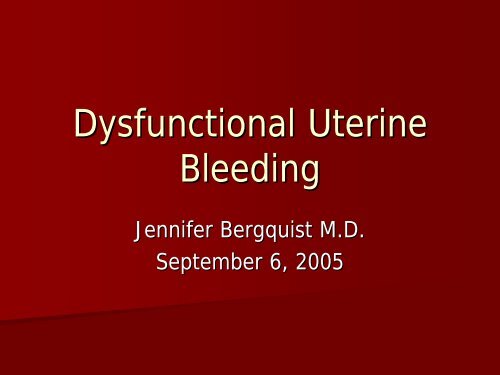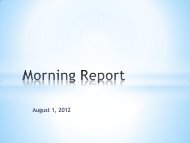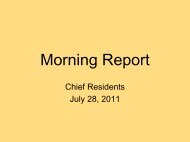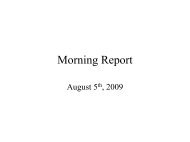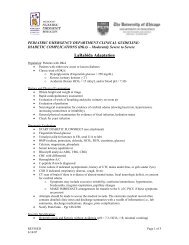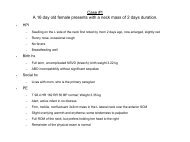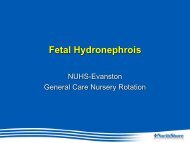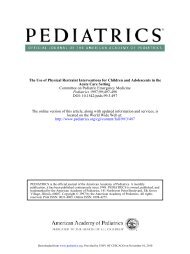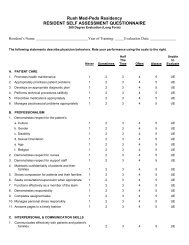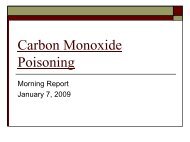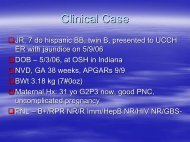Dysfunctional Uterine Bleeding - September 2005
Dysfunctional Uterine Bleeding - September 2005
Dysfunctional Uterine Bleeding - September 2005
Create successful ePaper yourself
Turn your PDF publications into a flip-book with our unique Google optimized e-Paper software.
<strong>Dysfunctional</strong> <strong>Uterine</strong><br />
<strong>Bleeding</strong><br />
Jennifer Bergquist M.D.<br />
<strong>September</strong> 6, <strong>2005</strong>
Case #1<br />
You are evaluating a 13yr old girl in your office.<br />
She is c/o heavy menstrual bleeding. She<br />
experienced menarche ~1yr ago and says her<br />
periods never occur at the same time. They last<br />
~10days. Her previous menses occurred ~2<br />
months ago. She denies dysmenorrhea. dysmenorrhea.<br />
Her<br />
current period started 2 days ago and is<br />
especially heavy. She denies sexual activity or<br />
h/o STDs.<br />
Physical exam findings are notable for mild<br />
orthostatic hypotension and pallor; Exam is<br />
otherwise normal
Case #2<br />
You are evaluating a 13yr old girl in your office.<br />
She is c/o heavy menstrual bleeding. She<br />
experienced menarche ~1yr ago and says her<br />
periods never occur at the same time. They last<br />
~10days. Her previous menses occurred ~2<br />
months ago. She denies dysmenorrhea. dysmenorrhea.<br />
Her<br />
current period started 2 days ago and is<br />
especially heavy. She denies sexual activity or<br />
h/o STDs.<br />
Physical exam is notable for mild orthostatic<br />
hypotension and pallor. She is mildly<br />
overweight and is noted to have acne. Exam is<br />
otherwise normal
Case #3<br />
You are evaluating a 13yr old girl in your office.<br />
She is c/o heavy menstrual bleeding. She<br />
experienced menarche 6 months ago and says<br />
her periods have always been heavy and last up<br />
to 12 days. Although, she thinks they occur at<br />
regular intervals. She frequently experiences<br />
dysmenorrhea. dysmenorrhea.<br />
She denies sexual activity or h/o<br />
STDs.<br />
Physical exam findings are notable for mild<br />
orthostatic hypotension, pallor and a large<br />
amount of menstrual blood at the vaginal<br />
introitus. introitus.<br />
Exam is otherwise normal.
Questions<br />
1. What is the differential diagnosis?<br />
2. What additional information would be helpful?<br />
3. What laboratory evaluation would you pursue?<br />
4. What initial therapy would help the patient’s patient s<br />
symptoms?
Definition<br />
<strong>Dysfunctional</strong> uterine bleeding (DUB) is defined<br />
as abnormal uterine bleeding that is excessive or<br />
occurs outside the normal cycle<br />
In Adolescents, 95% is secondary to anovulation<br />
anovulation<br />
Patterns of abnormal bleeding:<br />
– Menorrhagia Menorrhagia prolonged bleeding at regular intervals<br />
– Metrorrhagia Metrorrhagia uterine bleeding at irregular intervals<br />
– Menometrorrhagia Menometrorrhagia uterine bleeding that is<br />
prolonged, excessive and occurring at irregular<br />
intervals
Menarche<br />
Mean age of menarche in the United<br />
States:<br />
– 12.88 years for Caucasian girls<br />
– 12.16 years for African American girls<br />
90% reach menarche by the time breast<br />
and pubic hair development has reached<br />
SMR stage 4.<br />
On average, menarche occurs 2 years<br />
after thelarche
Menstrual Cycle<br />
Follicular Phase<br />
– Pulsatile GnRH<br />
– FSH and LH stimulate ovarian<br />
follicle growth<br />
– Predominant follicle secretes<br />
estrogen<br />
– Endometrium proliferates<br />
Ovulation<br />
– LH > FSH<br />
– Occurs 12hrs after LH surge<br />
Luteal Phase<br />
– Corpus Luteum secretes<br />
progesterone<br />
– Secretory endometrium<br />
– Corpus luteum regresses if no<br />
implantation occurs<br />
– Estrogen/progesterone fall;<br />
endometrial lining sloughs
Anovulatory Menstrual Cycle<br />
Endometrium experiences continued estrogen<br />
stimulation that is unopposed by progesterone<br />
Increased estrogen should cause a negative feedback on<br />
the H-P H P axis; estrogen levels fall; endometrium sloughs<br />
and mimics an ovulatory cycle<br />
In DUB, impairments in the feedback system cause the<br />
endometrium to be continuously stimulated, thickened<br />
and unstable<br />
<strong>Uterine</strong> bleeding occurs when endometrium outgrows its<br />
blood supply<br />
<strong>Uterine</strong> bleeding becomes asynchronous, prolonged and<br />
sometimes profuse
<strong>Dysfunctional</strong> <strong>Uterine</strong> <strong>Bleeding</strong><br />
Pregnancy-related related<br />
Pregnancy<br />
– Ectopic pregnancy<br />
– Abortion<br />
Physiologic<br />
– Post-menarchal<br />
Post menarchal<br />
(immature H-P-O H O Axis)<br />
differential diagnosis<br />
Physiologic Anovulation<br />
Hormonal contraceptives<br />
Hypothalamic-related<br />
Hypothalamic related<br />
– Systemic illness (DM, renal,<br />
liver disease)<br />
– Functional (diet, stress,<br />
exercise)<br />
– Eating disorders<br />
– Hypothyroid<br />
Pituatary-related<br />
Pituatary related<br />
– prolactinoma<br />
Outflow tract-related<br />
tract related<br />
– Trauma<br />
– Foreign body<br />
– Polyps<br />
– <strong>Uterine</strong> myomas<br />
– Neoplasms<br />
Androgen Excess<br />
– PCOS<br />
– Adrenal or ovarian tumor<br />
– Adrenal hyperplasia (non-<br />
classic type)<br />
Coagulation defects<br />
– Clotting factor deficiency<br />
– Von Willebrand disease<br />
Infectious<br />
– PID, cervicitis, cervicitis,<br />
vaginitis
Detailed menstrual<br />
history<br />
– Age of menarche<br />
– Menstrual pattern<br />
– Amount of blood loss<br />
– Duration of menses<br />
– +/- +/ menstrual cramps<br />
– Recent changes in<br />
cycles<br />
symptoms of<br />
hypovolemia<br />
Genital trauma<br />
Evaluation<br />
Weight loss or gain<br />
Non-menstrual Non menstrual bleeding<br />
(easy bruising)<br />
Emotional stress<br />
Exercise patterns<br />
Sexual history<br />
Gestational events<br />
Symptoms of chronic<br />
illness<br />
Family history of<br />
menstrual or bleeding<br />
disorders
Physical Exam<br />
Vital signs (including orthostatics)<br />
orthostatics<br />
Gen: obesity, cachexia<br />
HEENT: fundoscopic exam/visual field testing<br />
Neck: thyroid<br />
Breasts: SMR, evaluate for galactorrhea<br />
Abdominal: uterine/ovarian mass<br />
Skin: hirsutism, hirsutism,<br />
acne, acanthosis nigrans<br />
External genital exam: SMR, clitoral size<br />
Internal genital exam (if sexually active or has painful<br />
bleeding):uterine/adnexal<br />
bleeding): uterine/adnexal masses, motion tenderness,<br />
trauma, cervical os (size, color, discharge)
Urine B-HCG* B HCG*<br />
Laboratory Assessment<br />
– Even in adolescents who claim they are not sexually active!<br />
Hematocrit*<br />
Hematocrit<br />
CBC, PT/PTT<br />
– Should be performed in pts with + family history of bleeding d/o<br />
and/or personal h/o excessive non-menstrual non menstrual bleeding<br />
– Secondary evaluation includes a von Willebrand panel (vWF ( vWF<br />
antigen; ristocetin cofactor activity)<br />
Other tests (depending on history/physical)<br />
– FSH, LH, prolactin, prolactin,<br />
androgen panel (free/total testosterone,<br />
DHEA), TSH, Cortisol<br />
– Pelvic ultrasound- ultrasound always indicated in pts suspected of having<br />
ectopic pregnancy, pts who have a palpable mass or if PCOS is<br />
suspected<br />
* Should be performed in all patients with irregular uterine<br />
bleeding
Diagnostic Evaluation<br />
Progesterone Challenge<br />
– Evaluates uterine response to endogenous estrogen<br />
– Progesterone is administered X 12 days to mimic<br />
physiologic secretion<br />
– Menstrual bleeding within 1 week after the challenge<br />
suggests FSH/LH secretion is sufficient to maintain<br />
normal estradiol secretion and endometrial<br />
proliferation, but insufficient to cause ovulation<br />
– Lack of menstrual bleeding suggests an endometrial<br />
pathology or marked hypoestrogenemia
Physiologic Anovulation<br />
Immaturity of the hypothalamic-pituitary<br />
hypothalamic pituitary-<br />
ovarian axis is the most common cause (in the<br />
absence of pregnancy)<br />
– Rising levels of estrogen do not cause suppression of<br />
FSH; sustained estrogen secretion ensues<br />
Most common during the first 2 years after<br />
menarche when 55-80% 55 80% of cycles are<br />
anovulatory<br />
Regardless of cause, anovulation can present as<br />
either amenorrhea or DUB<br />
Laboratory evaluation may reveal elevated<br />
FSH:LH ratio<br />
It is a diagnosis of exclusion
Polycystic Ovarian Syndrome<br />
Should be considered in any any adolescent girl with<br />
hirsutism, hirsutism,<br />
menstrual irregularity or obesity<br />
2/3 have anovulatory symptoms<br />
– Primary or secondary amenorrhea or DUB<br />
Metabolic abnormalities<br />
– Obesity (50%), insulin resistance, glucose intolerance and lipid<br />
abnormalities<br />
Diagnosis (clinical + biochemical criteria)<br />
– Elevated LH:FSH ratio, elevated free testosterone<br />
– Pelvic ultrasound finding of polycystic ovaries (“string ( string of<br />
pearls”); pearls );<br />
~45% of adolescents have normal-appearing normal appearing ovaries<br />
Useful to exclude tumor from the differential<br />
– Exclusion of other disorders that mimic PCOS<br />
Virilizing tumors, hyperprolactinemia, hyperprolactinemia,<br />
non-classical non classical CAH, Cushing
Coagulation Disorders<br />
Often presents as menorrhagia at regular intervals<br />
When to consider bleeding disorders:<br />
– extremely heavy first menses, bleeding requiring blood<br />
transfusion, refractory menorrhagia w/ anemia<br />
All patients requiring hospitalization for uterine bleeding<br />
requires an evaluation for a coagulation disorder<br />
Approximately 20% of adolescents with menorrhagia<br />
were found to have a coagulation defect<br />
Von Willebrand disease was the most common defect<br />
(Factor XI deficiency was second)<br />
Blood for evaluation of bleeding disorders should be<br />
obtained before before administration of blood products or<br />
estrogen (may elevate vWF into the normal range)
Treatment: Treatment<br />
Hormonal Therapy Therapy<br />
Primary purpose is to stabilize endometrial<br />
proliferation and promote shedding<br />
>90% of adolescents with DUB respond to<br />
hormonal therapy<br />
– Alternative diagnosis should be considered for non-<br />
responders<br />
Estrogen “heals heals” sites of bleeding by causing<br />
further proliferation and providing hemostasis<br />
Progesterone stops proliferation and stabilizes<br />
the endometrial lining
Treatment: Treatment<br />
Mild Mild DUB DUB<br />
Longer than normal menses or shortened<br />
cycles for >2 months<br />
Observation and Reassurance<br />
– If anemia is not present/normal physical exam<br />
Menstrual calendar recommended<br />
Iron supplementation recommended<br />
despite normal hemoglobin<br />
Follow-up Follow up in 3-6 3 6 months
Treatment: Treatment<br />
Moderate DUB DUB<br />
Moderately prolonged or frequent menses every<br />
1-3 3 weeks w/ moderate-heavy moderate heavy menstrual flow<br />
Mild anemia is often present w/out signs of<br />
hypovolemia<br />
Outpatient management with hormonal therapy<br />
– Active Active bleeding: bleeding:<br />
combination oral contraceptives in<br />
tapering doses (minimum 30mcg estradiol) estradiol<br />
1 pill TID until bleeding ceases<br />
1 pill BID X 5 days<br />
1 pill QD X 21 days<br />
– No No Active Active bleeding: bleeding:<br />
Daily/Cyclic OCP<br />
progestin-only progestin only regimens are an alternative option:<br />
Medroxyprogesterone 10mg X first 12 days of the month
Treatment: Treatment<br />
Severe Severe DUB DUB<br />
Heavy menstrual bleeding causing a<br />
decrease in Hgb
Combination OCPs<br />
Treatment: Treatment<br />
Severe Severe DUB DUB<br />
OCPs (estradiol estradiol 50mcg)<br />
– 1 pill Q4 until bleeding subsides (usually within 24 hrs)<br />
– 1 pill QID X 4 days<br />
– 1 pill TID X 3 days<br />
– 1 pill BID X 2 weeks<br />
Conjugated IV estrogen 25mg IV Q4-6 Q4 6 is required for<br />
unstable patients<br />
– No more than 6 doses<br />
– <strong>Bleeding</strong> subsides 4-24 4 24 hrs<br />
– Persistent bleeding > 24hrs requires hemostatic therapy (anti-<br />
fibinolytic) fibinolytic)<br />
or uterine curettage should be considered (rare)<br />
– Combined OCPs should be initiated within 24-48 24 48 hrs of IV<br />
estrogen<br />
Anti-emetic Anti emetic therapy is recommended<br />
Blood transfusion is indicated in symptomatic patients
Maintenance Therapy<br />
Combination OCPs<br />
– Without significant anemia (Hgb ( Hgb >10)<br />
Cyclic therapy w/21 days + 7 days placebo<br />
– With significant anemia (Hgb ( Hgb
Therapy: Therapy<br />
Other Other Considerations<br />
Iron therapy should be included in ALL<br />
therapeutic regimens<br />
NSAIDs<br />
– Randomized control trials have shown<br />
reduction in menstrual blood loss of 30-50% 30 50%<br />
– Should be started at onset of menstruation<br />
and continued until end of menses<br />
– Helpful adjunct to hormonal therapy in pts<br />
with DUB and menorrhagia
Prognosis<br />
DUB should resolve with maturation of the<br />
H-P-O O axis<br />
Duration of time to maturity appears to be<br />
related to the age of menarche<br />
– 13 years: 50% at 4.5 years<br />
(% of ovulatory cycles)<br />
Prognosis depends upon underlying cause


